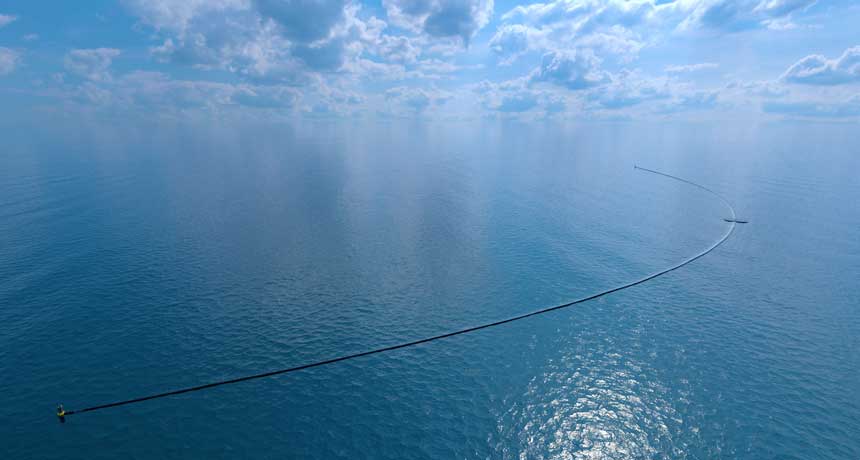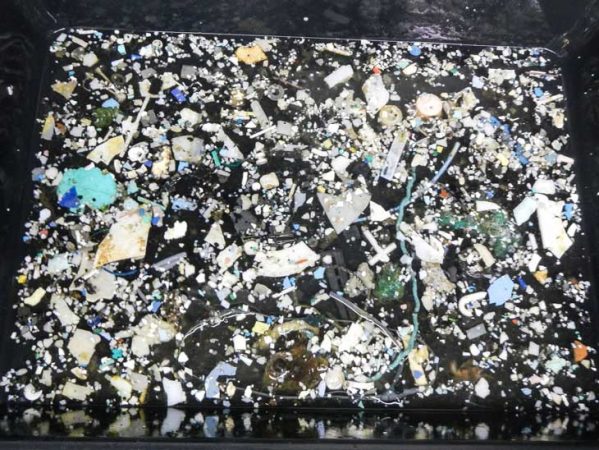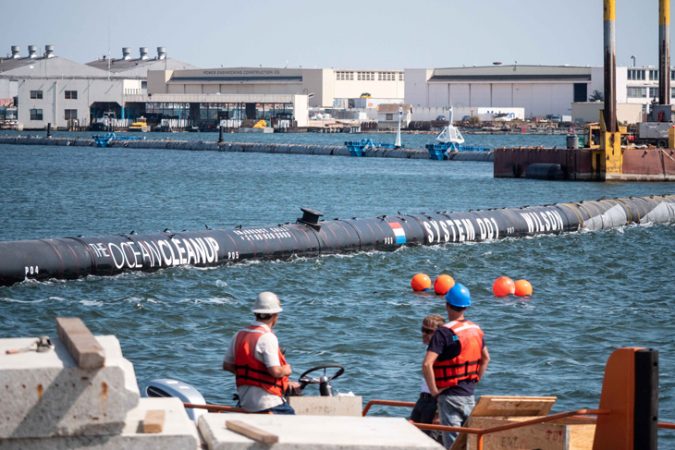Enormous floating barrier will corral ocean trash
Critics question whether it will do much good

This computer rendering shows what the 600-meter-long (2,000-foot) Ocean Cleanup system will look like floating in the North Pacific. Currents will push on the boom to form a u-shape. The system is designed to trap bits of plastic that boats can collect later.
The Ocean Cleanup
Watch out, ocean trash! On September 8, a project to scoop plastic debris from the ocean launched its first phase from Alameda, Calif. Called Ocean Cleanup, its creators claim it that by 2040 can remove 90 percent of the plastic in the Great Pacific Garbage Patch. If true, that would be a lot of plastic.
When researchers visited the that so-called garbage patch back in 2015, they estimated that it covered some 1.6 million square kilometers (620,000 square miles). That’s an area twice the size of Texas.
Boyan Slat first proposed Ocean Cleanup’s system in a 2012 TED talk. At the time, he was just 18 years old. The Dutch-born inventor’s system consists of many floating tubes. Known as booms, they form a long, snaking line. This barrier will collect floating plastic trash so people can come by and retrieve it. People have donated more than $30 million to fund the project, based in Delft, the Netherlands.
Not everyone, however, thinks it’s a great idea. Some researchers worry the project could harm ocean life. There’s also the issue of the targets’ size. Ocean Cleanup is designed to capture pieces of plastic ranging from a few millimeters in diameter to tens of meters across, such as fishing nets. In fact, bits smaller than half a centimeter across — so-called microplastics — make up the majority of ocean plastic. The project has not been designed to catch such small bits.
Critics also worry the project will take attention and money away dealing with the root cause of this pollution: too much plastic waste in the first place.

Ready for launch
Laurent Lebreton is Ocean Cleanup’s lead oceanographer. He led a study of the Great Pacific Garbage Patch. This is an infamous collection of trash in the Pacific Ocean. The trash collects in a vast ocean swirl known as the North Pacific gyre.
A new study estimates that this patch includes about 1.8 trillion pieces of debris. Buoyant plastics, such as polyethylene (Pah-lee-ETH-eh-leen) and polypropylene (Pah-lee PRO-puh-leen), dominate. Most are pieces smaller than half a centimeter (0.2 inch) across. But by mass, most of the bits of plastic —90 percent — are pieces 5 centimeters or bigger.
Lebreton’s team shared its findings March 22 in Scientific Reports.
It’s those larger pieces that Ocean Cleanup has been designed to snag. Its line of floating booms 600 meters (almost 2,000 feet) long will drift on the water, driven by winds, waves and ocean currents. Currents will naturally push the line of booms into a u-shape. And that will corral plastic debris as it travels. Beneath the surface, the booms drag a 3-meter-long (10-foot) skirt. This net will let only the tiniest bits of plastic escape.
Solar-powered lights, satellite antennas and other equipment show boats where the booms are. These features should help prevent boats from colliding with the booms. They’ll also help project scientists track where the floating system is. Periodically, boats will go out to the booms and ferry home much of the plastic it’s holding for recycling.
A line of test booms, called “System 001,” launched September 8. Ocean Cleanup has also tested parts of the system in the North Sea and off the California coast. After two weeks of testing off California, System 001 will head to the North Pacific gyre, Lebreton says. If all goes well, it should arrive within five weeks of the launch date. “We’re hoping to bring the first plastic back before the end of the year,” he says.
Ocean Cleanup plans to eventually have about 60 such systems. With the full fleet deployed, the group says, it should be able to remove 50 percent of the plastic in the patch within five years. By 2040, it hopes to have eliminated 90 percent — by weight.

New ecosystems
Plastic is bad for the environment. But no one knows whether the boom-and-cleanup system itself might pose any harm.
Ocean Cleanup hired an outside group to investigate how the system might affect marine life. Its report, published in July, found no reasons for serious concern. But it did note one small concern: Sea turtles might be drawn to the system and then eat the trash.
There are many other issues the report didn’t cover, says Kim Martini. She’s a physical oceanographer at Sea-Bird Scientific. This Seattle-based company makes tools to measure ocean properties. Martini wrote about Ocean Cleanup in January 2017 for the oceanography blog Deep Sea News. In her piece, she listed some worries. For example, the booms’ sweeping net could gather marine hitchhikers, from algae to barnacles and other kinds of critters. They could add drag to the system and change how well it performs, she says.
Also unknown, she says, is whether herding the plastic will cause new, tiny ecosystems to form amidst the trash. This could possibly attract even more wildlife to the area that the system might then scoop up by accident.
Another big issue, Martini says, is that there’s no evidence yet that the system can actually collect much plastic. The latest California trial will be the first real test of how well the system may works.
Marcus Eriksen also doubts the system will collect as much plastic as Ocean Cleanup’s team claims. He’s an environmental scientist at 5 Gyres Institute. This is a nonprofit in Los Angeles, Calif. Eriksen worked with Lebreton worked on a 2014 study of ocean plastic. It estimated that there are 5 trillion bits of ocean plastic worldwide. But many of these bits quickly leave the surface, they reported in the journal PLOS ONE.
A lot of the debris washes ashore, gets shredded or sinks, Eriksen says. So many of the small particles would end up below the project’s 3-meter-deep skirt. Meanwhile, new particles are always entering the ocean. That’s why 5 Gyres and other conservation groups are focused on prevention, not cleanup. Persuading people to use less plastic in the first place is the best way to reduce ocean trash, Eriksen says.
Every effort helps
The Ocean Cleanup team says its project is meant to work together with such prevention measures. For now, it’s worth trying to remove whatever is already floating near the surface, they argue.
Whatever the result of their new tests, some groups are applauding Ocean Cleanup for raising awareness of the ocean’s plastic trash problem.
“I love how passionate people are about the Ocean Cleanup project,” says Adam Lindquist. He’s director of the Healthy Harbor Initiative in Baltimore, Md. His group installed a pair of water wheels at two river mouths in his city’s Inner Harbor area. Anchored to the ocean floor, the floating are have booms and skirts much like those on the Ocean Cleanup system. The two wheels are nicknamed Mr. Trash Wheel and Professor Trash Wheel. In four and a half years, they’ve scooped up some 900 tons of debris — ranging from contact lenses to mattresses. This was all trash kept out of the ocean.
“Any tech that’s removing plastics from the ocean is a good thing,” Lindquist says. But the bigger value in such programs will be their “getting people to take the problem more seriously, so that we can move toward real solutions.” In other words, stopping plastic from entering the ocean in the first place.







